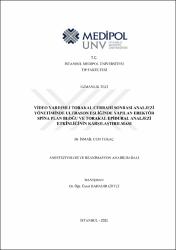| dc.contributor.advisor | Çiftçi, Bahadır | |
| dc.contributor.author | Tukaç, İsmail Cem | |
| dc.date.accessioned | 2022-01-19T06:20:07Z | |
| dc.date.available | 2022-01-19T06:20:07Z | |
| dc.date.issued | 2021 | en_US |
| dc.date.submitted | 2021 | |
| dc.identifier.citation | Tukaç, İ. C. (2021). Video yardımlı torakal cerrahi sonrası analjezi yönetiminde ultrason eşliğinde yapılan erektör spina plan bloğu ve torakal epidural analjezi etkinliğinin karşılaştırılması. (Yayınlanmamış uzmanlık tezi). İstanbul Medipol Üniversitesi Tıp Fakültesi, İstanbul. | en_US |
| dc.identifier.uri | https://hdl.handle.net/20.500.12511/8833 | |
| dc.description.abstract | Giriş/Amaç: Torakotomi sonrası analjezi yönetimi için altın standart olan torakal epidural analjezi (TEA), video yardımlı torakoskopik cerrahi (Video-assisted thoracic surgery-VATS) sonrası analjezi için de kullanılmaktadır. Ultrasound (US) eşliğinde yapılan erektör spina plan bloğu (ESPB), Forero ve ark. tarafından 2016 yılında tanımlanmış yeni bir interfasiyal plan bloğudur. Erektör Spina Plan Bloğu'nun T5 vertebra seviyesinde uygulanınca torakal analjezi sağladığı bildirilmiştir. Bu çalışmanın amacı, VATS sonrası analjezi yönetiminde ESPB ve TEA' nın analjezik etkinliklerini kıyaslamaktır. Gereç/Yöntem: İstanbul Medipol Üniversitesi Tıp Fakültesi etik kurul onayı (28.12.2018 tarihli 21 karar no.lu) ve hasta onamları alındıktan sonra, genel anestezi altında elektif video yardımlı torakoskopik cerrahi planlanan, ASA risk skoru I-II olan 50 hasta çalışmaya dahil edildi. Kanama diyatezi hikayesi bulunan, antikoagülan tedavi alan, lokal anestezik ve opioid ilaçlara karşı alerjisi veya duyarlılığı olan, blok uygulanacak bölgede infeksiyonu olan, gebelik şüphesi ve/veya gebe olan, emziren anneler ve işlemi kabul etmeyen hastalar çalışma dışı bırakıldı. Hastalar bilgisayar randomizasyon programı yardımıyla iki gruba ayrıldı. Grup ESPB' (n=25) de ESPB, Grup TEA' (n=25) da TEA planlandı. Her iki gruba blok kateterinden hasta kontrollü analjezi (HKA) uygulandı. Postoperatif ilk 24 saatte her iki grubun VAS skorları, ek analjezik kullanımı, bulantı-kusma insidansları ve komplikasyonlar kaydedildi. Bulgular: ESPB grubunda TEA grubuna göre intraoperatif opioid (remifentanil) tüketimi, istatistiksel olarak anlamlı düşük saptandı (p<0.05). ESPB grubunda 16. ve 24. saatlerdeki hem statik (istirahatte) hem de dinamik (öksürürken) VAS değerleri, TEA grubuna göre anlamlı olarak yüksek bulundu (p<0.05). Her iki grup arasında, komplikasyonlar ve yan etkiler bakımından istatistiksel olarak anlamlı bir fark saptanmadı (p>0.05). Sonuç: Çalışmamızda, VATS sonrası analjezi yönetiminde ESPB ve TEA' nın benzer etkinlikte analjezi sağladığı görüldü. ESPB hem uygulama kolaylığı hem de güvenliği açısından torakoskopi sonrası analjezi yönetimi için TEA' ya iyi bir alternatif olabilir. | en_US |
| dc.description.abstract | Objective: Thoracic epidural analgesia (TEA) is the clinical gold standard post-thoracotomy analgesic technique, but it is also being used for analgesia management following video-assisted thoracic surgery (VATS). The ultrasound (US)-guided erector spinae plane block (ESPB) is a novel interfacial plane block described by Forero et al. in 2016. ESPB provides thoracic analgesia when it is performed on the level of T5 vertebrae. The aim of this study is to compare the efficacy of ESPB and TEA for postoperative analgesia management following VATS. Methods: After the approval of the Istanbul Medipol University ethical committee and obtaining consent from the patients, patients who had American Society of Anesthesiologists (ASA) classification of I–II and an age of 18 to 65 years old- scheduled for elective VATS under general anesthesia were included in this study. We excluded patients with bleeding diathesis histories, patients receiving anticoagulant treatment, patients with known local anesthetic or opioid allergies, patients with skin infections at the needle puncture site, pregnant or lactating patients, and those who did not agree to the procedure. The patients were divided into two groups of 25 patients each using a randomizing computer program: an ESPB group (n=25) and a TEA group (n=25). Patient-controlled analgesia (PCA) device was attached to patients via the catheter. The analgesic using in the postoperative first 24 hours, the incidence of nausea and vomiting, and complications were recorded. Results: The intraoperative opioid consumption was significantly lower in ESPB group compared to TEA group (p<0,05). The static (at rest) and dynamic (while cough) VAS at 16th and 24th hours were significantly higher in ESPB group compared to TEA group. There was no difference in terms of side effects and complications between the groups. Conclusions: ESPB and TEA provided similar effective analgesia management following VATS. ESPB may be a good alternative to TEA for analgesia management after thoracoscopy, due to its safety and ease of application. | en_US |
| dc.language.iso | tur | en_US |
| dc.publisher | İstanbul Medipol Üniversitesi Tıp Fakültesi | en_US |
| dc.rights | info:eu-repo/semantics/openAccess | en_US |
| dc.subject | Erektör Spina Plan Bloğu | en_US |
| dc.subject | Postoperatif Analjezi Yönetimi | en_US |
| dc.subject | Torakal Epidural Analjezi | en_US |
| dc.subject | Video Yardımcılı Torakoskopik Cerrahi | en_US |
| dc.subject | Video-Assisted Thoracic Surgery | en_US |
| dc.subject | Thoracic Epidural Analgesia | en_US |
| dc.subject | Erector Spinae Plane Block | en_US |
| dc.subject | Postoperative Analgesia Management | en_US |
| dc.title | Video yardımlı torakal cerrahi sonrası analjezi yönetiminde ultrason eşliğinde yapılan erektör spina plan bloğu ve torakal epidural analjezi etkinliğinin karşılaştırılması | en_US |
| dc.title.alternative | Comparison about the efficacy of erector spinae plane block and thoracic epidural analgesia for postoperati̇ve analgesia management following video assisted thoracic surgery | en_US |
| dc.type | specialtyThesis | en_US |
| dc.department | İstanbul Medipol Üniversitesi, Tıp Fakültesi, Cerrahi Tıp Bilimleri Bölümü, Anesteziyoloji ve Reanimasyon Ana Bilim Dalı | en_US |
| dc.relation.publicationcategory | Tez | en_US |


















